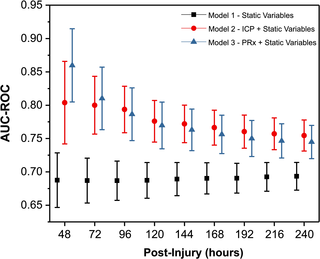PLOS Medicine ( IF 10.5 ) Pub Date : 2017-07-25 , DOI: 10.1371/journal.pmed.1002353 Hadie Adams 1 , Joseph Donnelly 1 , Marek Czosnyka 1, 2 , Angelos G Kolias 1 , Adel Helmy 1 , David K Menon 3 , Peter Smielewski 1 , Peter J Hutchinson 1

|
Background
Both intracranial pressure (ICP) and the cerebrovascular pressure reactivity represent the dysregulation of pathways directly involved in traumatic brain injury (TBI) pathogenesis and have been used to inform clinical management. However, how these parameters evolve over time following injury and whether this evolution has any prognostic importance have not been studied.
Methods and findings
We analysed the temporal profile of ICP and pressure reactivity index (PRx), examined their relation to TBI-specific mortality, and determined if the prognostic relevance of these parameters was affected by their temporal profile using mixed models for repeated measures of ICP and PRx for the first 240 hours from the time of injury. A total of 601 adults with TBI, admitted between September 2002 to January 2016, and with high-resolution continuous monitoring from a single centre, were studied. At 6 months postinjury, 133 (19%) patients had a fatal outcome; of those, 88 (78%) died from nonsurvivable TBI or brain death. The difference in mean ICP between those with a fatal outcome and functional survivors was only significant for the first 168 hours after injury (all p < 0.05). For PRx, those patients with a fatal outcome also had a higher (more impaired) PRx throughout the first 120 hours after injury (all p < 0.05). The separation of ICP and PRx was greatest in the first 72 hours after injury. Mixed models demonstrated that the explanatory power of the PRx decreases over time; therefore, the prognostic weight assigned to PRx should similarly decrease. However, the ability of ICP to predict a fatal outcome remained relatively stable over time. As control of ICP is the central purpose of TBI management, it is likely that some of the information that is reflected in the natural history of ICP changes is no longer apparent because of therapeutic intervention.
Conclusions
We demonstrated the temporal evolution of ICP and PRx and their relationship with fatal outcome, indicating a potential early prognostic and therapeutic window. The combination of dynamic monitoring variables and their time profile improved prediction of outcome. Therefore, time-driven dynamic modelling of outcome in patients with severe TBI may allow for more accurate and clinically useful prediction models. Further research is needed to confirm and expand on these findings.
中文翻译:

严重创伤性脑损伤中颅内压和脑血管反应性的时间分布及其与致命结果的关联:一项观察性研究
背景
颅内压 (ICP) 和脑血管压力反应性都代表直接参与创伤性脑损伤 (TBI) 发病机制的通路的失调,并已用于临床管理。然而,尚未研究这些参数在受伤后如何随着时间的推移而演变,以及这种演变是否具有任何预后重要性。
方法和发现
我们分析了 ICP 和压力反应指数 (PRx) 的时间分布,检查了它们与 TBI 特异性死亡率的关系,并确定这些参数的预后相关性是否受其时间分布的影响,使用混合模型重复测量 ICP 和 PRx受伤后的前 240 小时。研究了 2002 年 9 月至 2016 年 1 月期间入院的 601 名 TBI 成人,并在一个中心进行高分辨率连续监测。受伤后 6 个月,133 名 (19%) 患者出现致命结果;其中,88 人(78%)死于无法存活的 TBI 或脑死亡。具有致命结果的患者和功能性幸存者之间的平均 ICP 差异仅在受伤后的前 168 小时内显着(所有p< 0.05)。对于 PRx,那些具有致命结果的患者在受伤后的前 120 小时内也有更高(受损程度更大)的 PRx(所有p < 0.05)。ICP 和 PRx 的分离在受伤后的前 72 小时内最大。混合模型表明 PRx 的解释力随着时间的推移而降低;因此,分配给 PRx 的预后权重应该同样降低。然而,ICP 预测致命结果的能力随着时间的推移保持相对稳定。由于控制 ICP 是 TBI 管理的中心目的,因此在 ICP 变化的自然病程中反映的一些信息很可能由于治疗干预而不再明显。
结论
我们展示了 ICP 和 PRx 的时间演变及其与致命结果的关系,表明潜在的早期预后和治疗窗口。动态监测变量及其时间分布的组合改进了对结果的预测。因此,时间驱动的严重 TBI 患者结果的动态建模可能允许更准确和临床有用的预测模型。需要进一步的研究来证实和扩展这些发现。











































 京公网安备 11010802027423号
京公网安备 11010802027423号